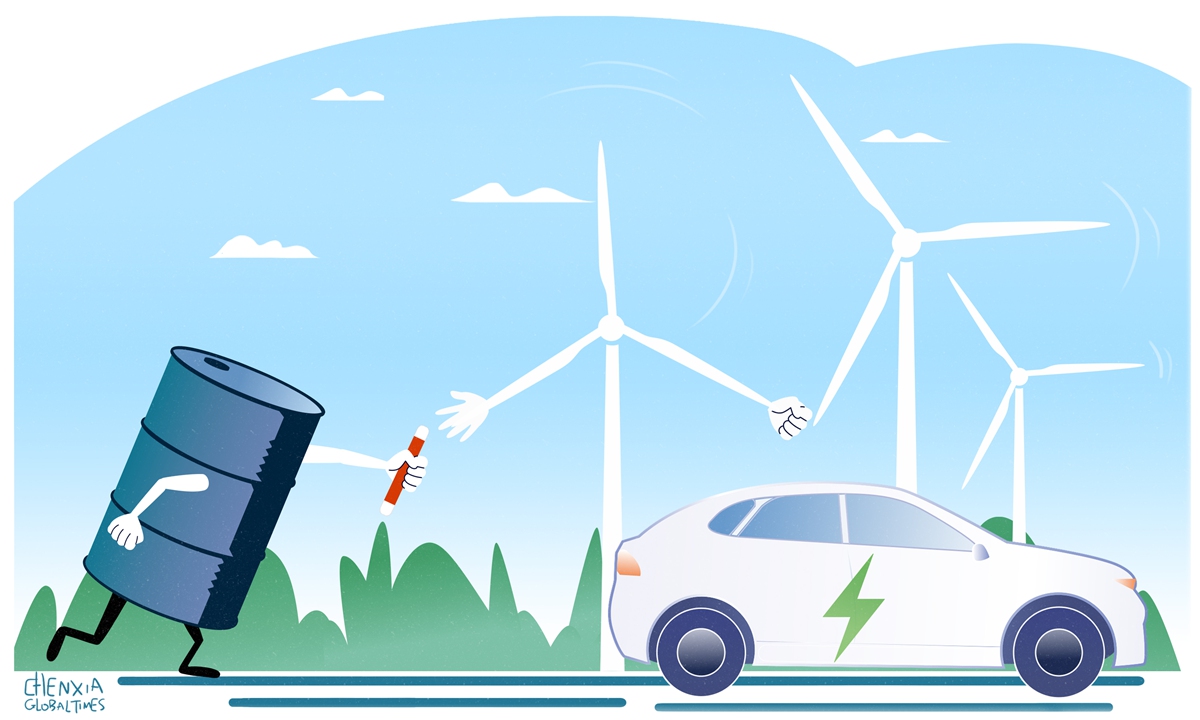
Illustration: Chen Xia/GT
While overall oil demand remains stable, the structure of oil consumption in China is experiencing rapid changes. Recent data from a report by China National Petroleum Corp (CNPC) indicate that China's oil demand is nearing a turning point, highlighting the significant progress of China's green transformation.China's oil demand is projected to peak at 770 million tons in 2025, according to the CNPC report.
Data from foreign institutions show similar trends. Growth in Chinese oil consumption hit the brakes after surging in 2023, the International Energy Agency (IEA) said in September.
The shifts in China's oil demand are not merely fluctuations in numbers. They profoundly reflect China's evolving role in the global energy sector, transitioning from a major oil consumer to a leader in energy transformation.
However, some Western media outlets are interpreting the decline in China's oil demand as a signal that "the slowdown of the Chinese economy is dragging down the global oil market." For instance, Reuters published a report with the headline "IEA cuts 2024 oil demand growth forecast on China slowdown" in September, while a report in the Wall Street Journal on Monday came with the title "China's EV Boom Is Starting to Pinch Oil Producers." Such perspectives are misguided.
In fact, in the past few decades, China's robust economic growth has reshaped supply and demand patterns in international oil markets. China accounted for 16 percent of global demand in 2023, up from around 9 percent in 2008, WSJ reported, citing IEA data. As a major oil-consuming country, China has made significant contributions to the global oil market.
Currently, China's oil consumption is expected to reach its peak, marking the most significant change on the demand side of the international oil market. But it is important to note that although China's oil imports edged down this year, their contribution should not be underestimated. Using this to discredit the Chinese economy is even more unfounded.
Against the backdrop of a global economy facing headwinds, China is resolutely pushing for a shift toward a greener and more sustainable growth model, achieving significant accomplishments in its green transformation. In 2024, China's new energy vehicles and other emerging industries continue to grow rapidly, and their support for the economy is steadily increasing.
China's high emphasis on environmental protection and sustainable development has driven profound adjustments in its energy structure. From vigorously developing new energy sources to promoting energy-saving technologies and improving energy efficiency, a series of policy measures has led to a dramatic transformation in China's energy consumption structure. The earlier than expected peak in oil demand is a reflection of this change.
In 2025, the global economy faces the multiple challenges of slowing growth momentum and increasing uncertainty. As the world's second-largest economy, China is adapting to economic shifts and new technologies, with its internal economic drivers gradually strengthening. It is projected that China's economic growth will remain stable while seeing progress in structural improvements. The IMF projected China's GDP to grow by 4.8 percent in 2024 despite headwinds. China's energy supply and demand structure is expected to become greener and more resilient.
By vigorously developing clean energy sources such as wind and solar power, China is not only reducing its dependence on fossil fuels but also playing an increasingly important role in the global energy structure adjustment, making increasing contributions in global sustainable development.
By 2035, it is projected that China's electricity generated from non-fossil energy will exceed that from fossil energy, reaching 8.4 trillion kilowatt-hours, Chinese media outlet stdaily.com reported.
During the 15th Five-Year Plan (2026-30) period, the proportion of non-fossil energy consumption is expected to increase to 27 percent, according to the report.
As renewable energy technologies advance at an unprecedented pace and national policies provide robust support, China is poised to further solidify its position as a global leader in the energy transition. By fostering collaboration between government, industry, and research institutions, China aims to accelerate the adoption of clean energy, ultimately contributing to a more sustainable and resilient global energy landscape.
The author is a reporter with the Global Times. bizopinion@globaltimes.com.cn



